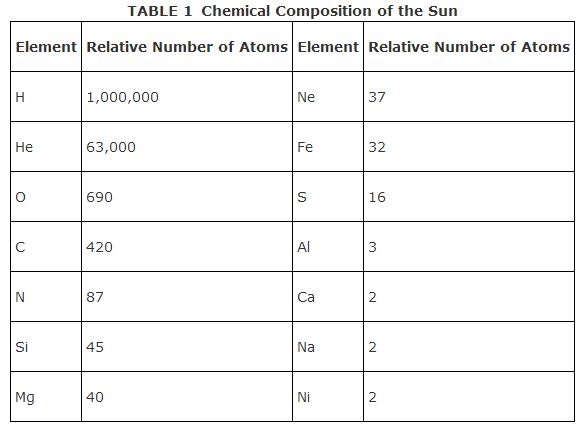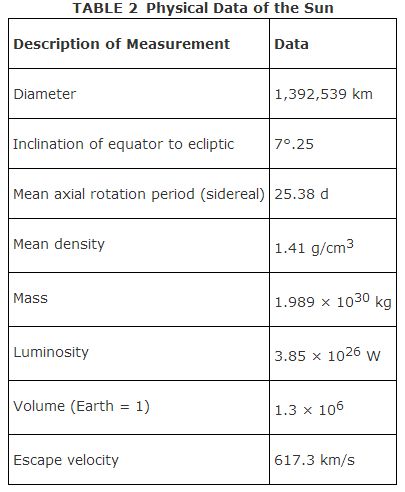The energy that we receive from the Sun dictates the environment on Earth that is so important to humanity's existence. But to astronomers, the Sun is the only star that can be studied in great detail; thus, studying the sun is vital to the understanding of stars as a whole. In turn, the study of stars shows us that our Sun is merely an average star, neither exceptionally bright nor exceptionally faint. Evidence from other stars has also revealed their life histories, allowing us a better understanding of the part and future of our particular star.
The solar diameter equals 109 Earth diameters, or 1,390,000 kilometers. What we see when we look at the sun, however, is not a solid, luminous surface, but a spherical layer, called the photosphere, from which the bulk of the solar light comes (see Figure ). Above the photosphere the solar atmosphere is transparent, allowing light to escape. Below the photosphere, the physical conditions of the material of the solar interior prevent light from escaping. As a result, we cannot observe this interior region from the outside. The solar mass is equivalent to 330,000 earth masses, or 2 × 10 30 kg, for a mean or average density (mass/volume) of 1.4 g/cm 3.

Figure 1
Cross-section of the Sun.
The rotation of the sun is made evident by the sunspots that cross the solar disk in about two weeks, then disappear, and then reappear at the opposite limb (or curved edge) two weeks later. Observations of the sun reveal that different parts of the Sun rotate at different speeds. For example, the equatorial rotational period is 25.38 days, but at latitude 35°, the period is 27 days. Sunspots aren't seen at higher latitudes, but use of the Doppler effect for light observed at latitude 75° reveals a longer period of 33 days. This differential rotation reveals that the Sun is not solid, but is gaseous or liquid.
The total energy emission of the sun, or luminosity, is 4 × 10 26 watts. This is found by measurement of the solar constant, the energy received per square meter (1,360 watts/m 2) by a surface perpendicular to the direction of the Sun at a distance of 1 astronomical unit and multiplying by the surface area of a sphere of radius 1 AU. The term solar constant implies a belief in a constant luminosity output for the Sun, but this may not be completely correct. The Maunder minimum, an era of very few detectable sunspots in the century after their discovery in 1610, suggests the solar sunspot cycle was not in operation at this time. Other evidence suggests the presence or lack of a solar cycle is related to changes in the solar luminosity output. Past ice ages of the Earth could be the result of a diminished solar luminosity output. Monitoring of the solar constant in the last decade from spacecraft suggests there are variations on the order of one‐half percent. Thus our Sun perhaps is not as constant a source of energy as was once believed.
The temperature of the solar “surface” (the photosphere) can be defined in several ways. Application of the Stefan‐Boltzman Law (energy emitted per second per unit area = σT 4) yields a value of 5,800 K. Wien's law, which relates the peak intensity in the spectrum to the temperature of the emitting material yields T = 6,350 K. This discrepancy between the two values results for two reasons. First, the emitted light comes from different depths in the photosphere and thus is a mixture of emission characteristics of a range of temperatures; thus, the solar spectrum is not an ideal black body spectrum. Second, absorption features significantly alter the spectrum from the shape of a black body spectrum.
The strongest absorption features were first studied by Fraunhofer (1814) and are called Fraunhofer lines. Absorption lines from over 60 elements have been identified in the solar spectrum. Analysis of their strengths gives temperatures at different depths in the photosphere and chemical abundance ratios. The most common elements are listed in Table 1.


Table 2 lists the Sun's physical data.